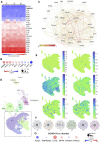Prediction of Non-canonical Routes for SARS-CoV-2 Infection in Human Placenta Cells
- PMID: 34820418
- PMCID: PMC8606885
- DOI: 10.3389/fmolb.2021.614728
Prediction of Non-canonical Routes for SARS-CoV-2 Infection in Human Placenta Cells
Abstract
The SARS-CoV-2 is the causative agent of the COVID-19 pandemic. The data available about COVID-19 during pregnancy have demonstrated placental infection; however, the mechanisms associated with intrauterine transmission of SARS-CoV-2 is still debated. Intriguingly, while canonical SARS-CoV-2 cell entry mediators are expressed at low levels in placental cells, the receptors for viruses that cause congenital infections such as the cytomegalovirus and Zika virus are highly expressed in these cells. Here we analyzed the transcriptional profile (microarray and single-cell RNA-Seq) of proteins potentially interacting with coronaviruses to identify non- canonical mediators of SARS-CoV-2 infection and replication in the placenta. Despite low levels of the canonical cell entry mediators ACE2 and TMPRSS2, we show that cells of the syncytiotrophoblast, villous cytotrophoblast, and extravillous trophoblast co-express high levels of the potential non-canonical cell-entry mediators DPP4 and CTSL. We also found changes in the expression of DAAM1 and PAICS genes during pregnancy, which are translated into proteins also predicted to interact with coronaviruses proteins. These results provide new insight into the interaction between SARS-CoV-2 and host proteins that may act as non-canonical routes for SARS-CoV-2 infection and replication in the placenta cells.
Keywords: COVID-19; CTSL; DAAM1; DPP4; PAICS; SARS-CoV-2; placenta; virus entry mediator.
Copyright © 2021 Constantino, Cury, Nogueira, Carvalho and Justulin.
Conflict of interest statement
The authors declare that the research was conducted in the absence of any commercial or financial relationships that could be construed as a potential conflict of interest.
Figures


References
-
- Chen H., Guo J., Wang C., Luo F., Yu X., Zhang W., et al. (2020). Clinical Characteristics and Intrauterine Vertical Transmission Potential of COVID-19 Infection in Nine Pregnant Women: A Retrospective Review of Medical Records. The Lancet 395, 809–815. 10.1016/S0140-6736(20)30360-3 - DOI - PMC - PubMed
LinkOut - more resources
Full Text Sources
Miscellaneous

